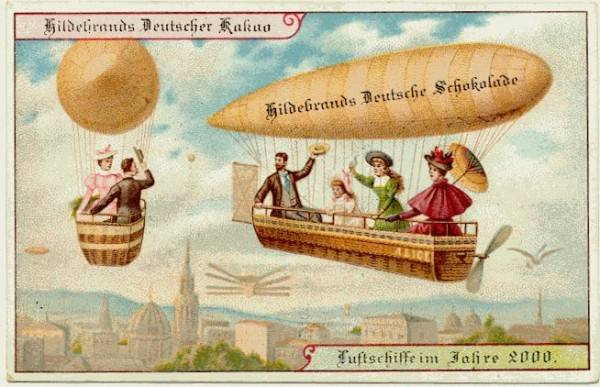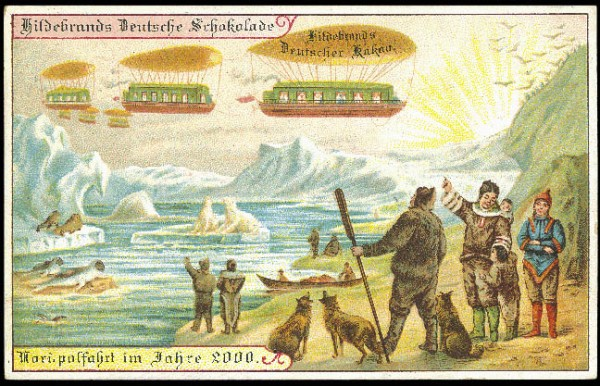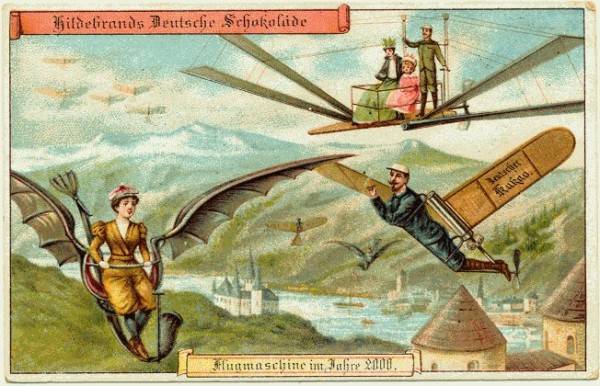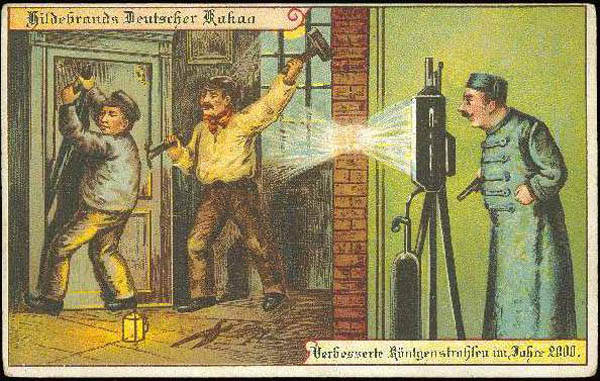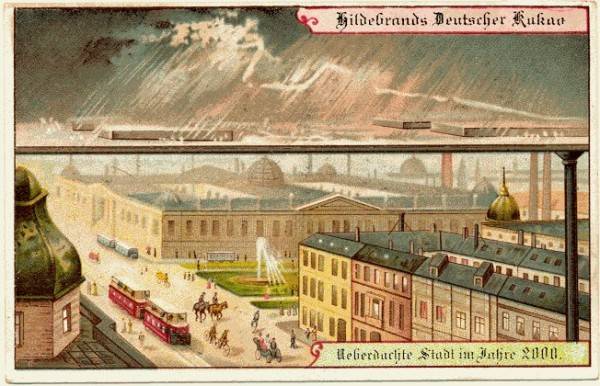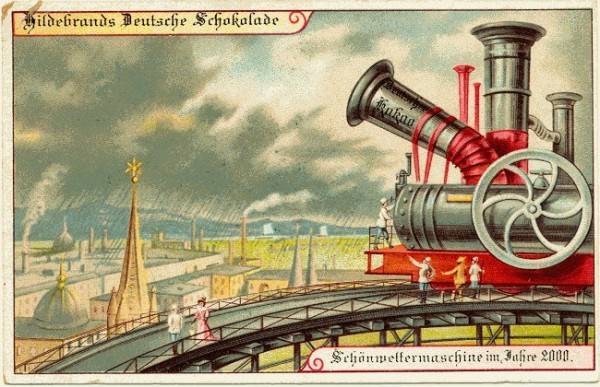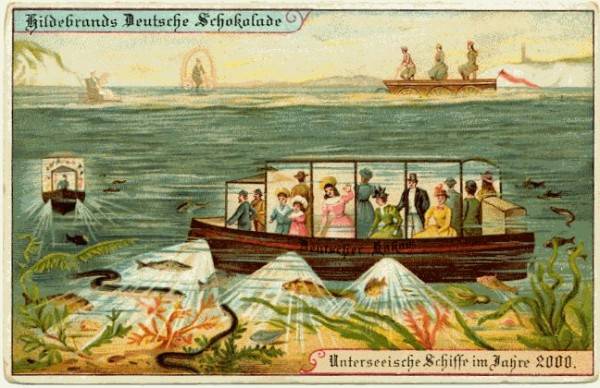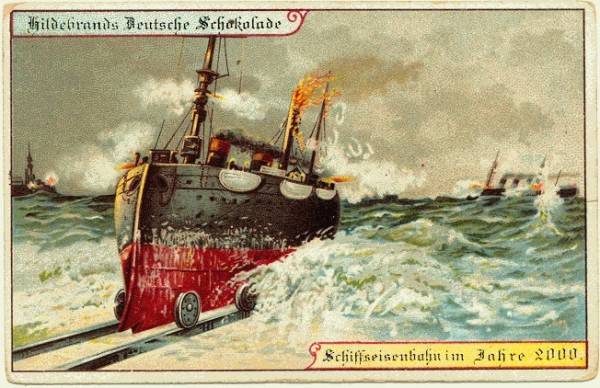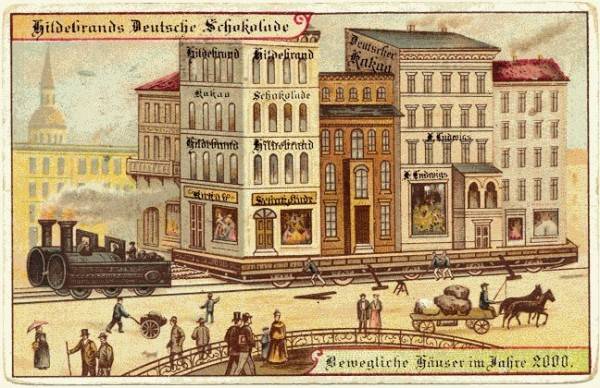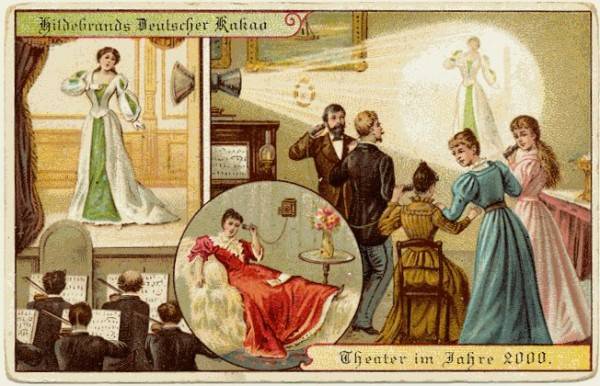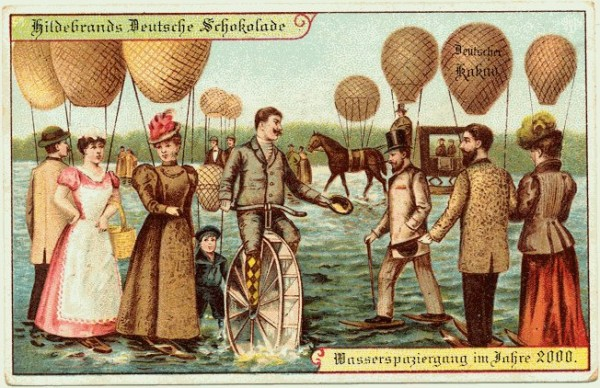If you’re as old as I am, you probably remember quite a few “predictions” about the year 2000. In the 1990s, it was all about how the computers were going to go haywire and plunge us into an informationless dark age causing people to stock up for an apocalypse scenario. I bet they felt a bit sheepish.
Cartoons in the midcentury loved showing the 2000s as full of hovercars and bubble helmets when space exploration became a reality. But predictions about the year 2000 date back even farther, and the predictions, by today’s standards, seem adorably quaint. They’re also educational, as they offer us a glimpse of the social values and scientific limitations existing 115 years ago.
In 1899 and 1900, a German chocolate company called Hildebrands created a series of postcards called “Life in the Year 2000.” These postcards depicted all kinds of crazy projections on what people would do in a hundred years. As you’ll see, they didn’t account for any changes in fashion.
1.) Personal Airships
The Victorian period was all about the airship, but they never caught on as methods of mass or individual travel. Plus there was that whole Hindenburg thing. Airships, or dirigibles, are mostly used to cover sports events and as advertising, though some people attempted to build their own.
2.) Taking Those Airships to the North Pole
Planes wouldn’t be mainstream for another few decades, so air travel was assumed to be via zeppelin. In the early ’30s, a German zeppelin did make it pretty far into the Arctic, which contributed to our knowledge of the region. No word on whether personal airships would make the journey.
3.) Personal Flying Machines
People have tried to perfect this for hundreds of years, and it got us the hang glider, the
wingsuit, and a whole lot of injuries. There are versions of these, but none are used for everyday transport.
4.) X-Ray Technology for the Police
The idea was to have cops use this “technology” to catch criminals in the act. I guess no one thought of the whole invasion-of-privacy thing. Today, this kind of happens, but not in the way they imagined. Rather, police use infrared technology to “see” through walls. Mostly, though, this is to detect drug production rather than burglaries. But there wasn’t meth in the Victorian period.
5.) Cities with Ceilings
The idea of a city covered in glass sounded pretty nice. People were sick of the nasty weather that would soak through all 498,363 layers of Victorian-era clothing. People do stay dry today, but in a slightly different fashion. Namely, people stay in their cars. The auto would not be invented for mass production for another few years, and early cars were open-topped. Today, we have roofed cars. Buildings are connected with skyways and covered structures in cold places. But city-wide ceilings, which influenced the sci-fi biodome, seem pretty unpleasant by today’s standards. Plus, we now have the knowledge of what’s known as the “greenhouse effect.”
6.) Weather-Controlling Machines
Maybe this was to eliminate those pesky glass ceilings. Well, we do have a little climate-change problem, so this kind of came true, but more in the disastrous manner. Environmentalism wasn’t something on the forefront of minds during this time. People were still on a high from industrialization, and wouldn’t necessarily think that there might be some setback to changing the climate. While we’re still doing that, climate control technology focuses on interiors, with inventions like central air conditioning and heating.
7.) Undersea Boats
Submarines existed during this time, but the hope was that passengers could enjoy the wonders of the sea with plenty of views. Of course, the amount of pressure would crack the glass pretty quickly. Deep sea observation technology has improved, but it’s still not open to the public. The best we have today are glass-bottom boats.
8.) Battleship Trains
The idea of a battleship on tracks seems absurd even by 1899 standards. For one thing, that means laying a lot of track pretty far out into the ocean. I guess the idea was they detached from the tracks, and the tracks on shore would end the need for docks? This doesn’t seem like a well thought-out plan, but it doesn’t matter. Neither trains nor ships play anywhere near the roles they did in wars anymore.
9.) Moving Sidewalks
Again, this is one of those things that did happen, but in a different way. Most airports have moving sidewalks to help people get from one place to another faster but they aren’t sitdown affairs. Sitdown sidewalks that move you from one place to another are called buses or trains.
10.) Moving Buildings with Trains.
I’m not sure when moving an entire city block by train is needed. It seems like a lot of infrastructure would likely have to come into play to make this a thing. Today, houses can be moved by truck. Mobile homes like campers and trailers also combine the mobility and the home into one structure.
11.) Long-Distance Theater
This is the most accurate prediction. Here, a performance is shown projected onto the wall of a family home. The viewers listen through earpieces, like those found on old telephones. We do have this today, just with slightly different technology. And sound is included!
12.) Walking Across Water
Personal waterwheel unicycles, boat-like shoes, and balloon attachments were considered a possible wave (ha!) of the future. It seems like long skirts would be the single worst garment for this activity. This didn’t happen, although we do have the phenomenon of stand-up paddling.
We think the Ladies Home Journal were more on the ball, as far as predicting the future was concerned. However, it’s fun to look back and see what people in the past thought their future would hold. They would probably enjoy taking selfies. We can only hope that, one day, someone will write an article on how silly our predictions for the future were! Just imagine a giant cockroach giggling, “Wow, the humans thought they would really last this long! Ha!”
